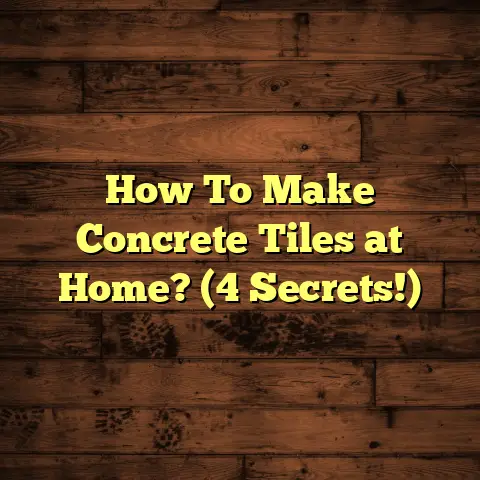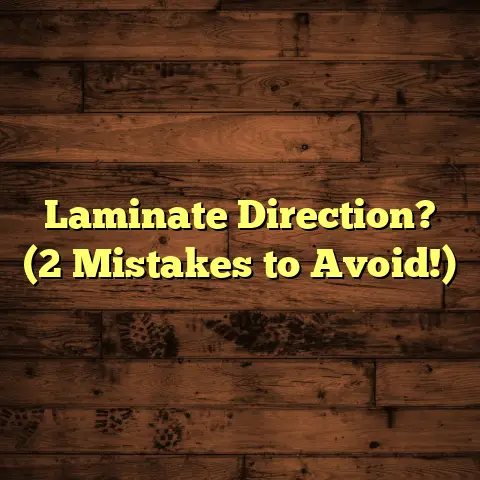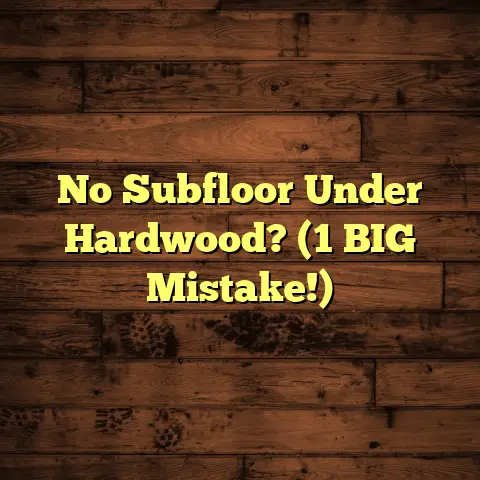Build A Shed On A Slab: How-To Guide? (7 Fatal Errors!)
Building a shed on a concrete slab is a popular choice for many homeowners.
It provides a stable, level foundation that can withstand the test of time.
But before you jump in, let’s talk about something that often gets overlooked: textures.
Think about concrete.
It’s not just one thing, right?
You’ve got smooth, brushed, stamped, and even exposed aggregate finishes.
Each texture has its own aesthetic appeal and functional implications.
- Smooth Concrete: Ideal for indoor spaces or areas where cleanliness is paramount.
- Brushed Concrete: Offers a non-slip surface, perfect for outdoor sheds.
- Stamped Concrete: Adds a decorative touch, mimicking stone or brick.
The texture of your slab affects the overall look of your shed.
A smooth slab might look sleek, but could be slippery when wet.
A rougher texture provides better grip and drainage, but might be harder to clean.
Understanding these nuances is crucial before you even think about pouring concrete.
You need to consider how the texture will impact water drainage, longevity, and the overall aesthetic of your shed.
Trust me, starting with the right texture sets the stage for a successful and long-lasting shed.
Let’s get into the nitty-gritty!
Section 1: Planning Your Shed on a Slab
Alright, let’s roll up our sleeves and dive into the planning phase.
This is where the magic happens, where your shed starts to take shape in your mind’s eye.
First things first: site selection. Where are you going to put this bad boy?
- Is it a level area?
- Is it easily accessible?
- Is it far enough from property lines?
Measure the space carefully.
I always recommend measuring twice and cutting once.
It’s a cliché, but it’s true!
Now, what kind of shed are we talking about?
A simple storage shed for garden tools?
A full-blown workshop for your woodworking projects?
The type of shed will heavily influence the design and size.
Here’s a quick breakdown:
Don’t forget about local zoning laws and permits! I can’t stress this enough.
Every region has its own rules and regulations regarding shed size, placement, and even color.
I once had a client who built a beautiful shed, only to be told by the city that it was too close to the property line.
Cost him a fortune to move it.
Save yourself the headache and do your homework beforehand.
Finally, let’s talk about the foundation.
A solid foundation is the backbone of any structure, and a concrete slab provides unparalleled stability for your shed.
It prevents settling, keeps moisture at bay, and gives you a level surface to work on.
Section 2: Choosing the Right Materials
Now that we’ve got the planning out of the way, let’s talk materials.
This is where you can really customize your shed to fit your needs and style.
Let’s start with the floor, since that’s what interacts directly with the slab.
You’ve got a few options here:
- Pressure-treated lumber: A classic choice, durable and resistant to rot and insects.
- Composite decking: Low-maintenance and weather-resistant, but can be pricier.
- Concrete: If you want an ultra-durable floor, you can pour a separate concrete floor inside the shed.
For the walls and roof, you’ve got even more choices:
- Wood: Timeless, easy to work with, and can be painted or stained to match your home.
- Metal: Durable, fire-resistant, and requires minimal maintenance.
- Vinyl: Lightweight, weather-resistant, and comes in a variety of colors and styles.
Here’s a quick comparison:
When selecting materials, think about how they’ll complement the texture of your concrete slab.
A rough, exposed aggregate slab might pair well with rustic wood siding, while a smooth, brushed slab might look better with sleek metal or vinyl.
Section 3: Preparing the Site and Pouring the Slab
Alright, time to get our hands dirty!
Preparing the site and pouring the slab is arguably the most crucial step in the whole process.
First, let’s talk about site preparation. This involves clearing the area of any vegetation, rocks, and debris.
Then, you need to grade the site to ensure proper drainage.
This means creating a slight slope away from your house.
I recommend a slope of at least 1/4 inch per foot.
Texture-related considerations are key here.
If you’re planning on a brushed concrete finish, you’ll want to make sure the ground is relatively smooth and free of large rocks that could interfere with the brushing process.
Next, let’s gather our tools and equipment. Here’s a checklist:
- Shovels
- Rakes
- Wheelbarrow
- Concrete mixer (or rent one)
- Forms (wood or metal)
- Rebar or wire mesh
- Concrete float
- Concrete edger
- Concrete broom (for brushed finish)
- Safety glasses and gloves
Now, let’s mix and pour the concrete. This is where things get a little tricky.
Follow these steps carefully:
- Mix the concrete according to the manufacturer’s instructions.
- Pour the concrete into the forms, making sure to fill all the corners and edges.
- Use a shovel or rake to distribute the concrete evenly.
- Insert rebar or wire mesh for added strength.
- Use a concrete float to smooth the surface.
- Use a concrete edger to create rounded edges.
- If you want a brushed finish, use a concrete broom to create the desired texture.
Curing the slab is just as important as pouring it. This process allows the concrete to harden properly and prevents cracking.
Keep the slab moist for at least 7 days by covering it with plastic sheeting or spraying it with water regularly.
The curing process also affects the final texture.
If the slab dries out too quickly, it can develop surface cracks and a rough, uneven texture.
Section 4: Building the Shed Frame
With the slab poured and cured, it’s time to build the shed frame.
This is where your shed starts to take shape and become a real, tangible structure.
The key here is to ensure the frame fits securely on the slab.
Any gaps or inconsistencies can lead to structural problems down the road.
Anchor bolts are your best friend. These are metal bolts that are embedded in the concrete slab and used to attach the frame to the foundation.
Here’s how to use them:
- Before pouring the concrete, place the anchor bolts in the wet concrete, ensuring they are properly spaced and aligned with the frame.
- After the concrete has cured, attach the frame to the anchor bolts using nuts and washers.
The texture of the slab can affect how well the anchor bolts grip the concrete.
A rougher texture provides better grip, while a smoother texture may require additional measures to ensure a secure connection.
Here are some common mistakes to avoid during the framing process:
- Using warped or damaged lumber.
- Failing to use proper fasteners.
- Not squaring the frame properly.
- Ignoring local building codes.
Section 5: Installing Walls and Roof
Now for the fun part: installing the walls and roof!
This is where your shed really starts to look like a shed.
Wall installation is pretty straightforward.
Simply attach the wall panels to the frame using nails or screws.
Make sure the panels are aligned properly and securely fastened.
Roof installation is a bit more challenging.
You’ll need to install rafters, sheathing, and roofing materials.
Make sure the roof is properly sloped to allow for water runoff.
Here are some insulation options to consider:
- Fiberglass insulation: A classic choice, affordable and easy to install.
- Spray foam insulation: Provides excellent insulation and seals air leaks, but can be pricier.
- Rigid foam insulation: Lightweight and easy to cut, but not as effective as fiberglass or spray foam.
Insulation can have a significant impact on the internal texture and temperature of your shed.
Proper insulation can help keep your shed cool in the summer and warm in the winter, while also preventing condensation and moisture buildup.
Finally, let’s talk about finishing touches. This includes things like siding, roofing materials, doors, windows, and trim.
These elements can enhance both the aesthetic and functional aspects of your shed.
Section 6: Seven Fatal Errors to Avoid
Alright, let’s talk about the things that can go horribly wrong.
I’ve seen these mistakes time and time again, and they can lead to structural failure, aesthetic issues, and a whole lot of frustration.
1. Ignoring Drainage
Inadequate drainage is a recipe for disaster.
Water can seep into the slab, causing it to crack and crumble.
It can also lead to rot and mildew in the shed itself.
Make sure to grade the site properly and install gutters and downspouts to divert water away from the shed.
2. Poor Site Preparation
Neglecting site grading can lead to uneven settling and structural problems.
Make sure to clear the site of all vegetation, rocks, and debris, and grade it properly to ensure a level and stable foundation.
3. Incorrect Slab Thickness
Improper slab thickness can lead to cracking and structural failure.
I recommend a minimum thickness of 4 inches for a shed slab.
If you’re planning on storing heavy items in the shed, you may need to increase the thickness.
4. Failure to Use Proper Anchors
Failing to secure the shed to the slab can lead to it being blown away in a strong wind.
Use anchor bolts to securely attach the frame to the foundation.
5. Choosing Incompatible Materials
Using materials that don’t work well together can lead to premature failure.
For example, using untreated lumber in contact with the concrete slab can lead to rot and decay.
6. Neglecting Insulation
Poor insulation can lead to temperature fluctuations, condensation, and moisture buildup.
Insulate your shed properly to keep it comfortable and prevent damage.
7. Overlooking Local Regulations
Ignoring local building codes and zoning laws can lead to fines, delays, and even the need to tear down your shed.
Do your homework and make sure you’re in compliance with all applicable regulations.
Conclusion
So, there you have it!
A comprehensive guide to building a shed on a concrete slab.
It’s a rewarding project, but it’s important to approach it with careful planning and execution.
Remember, the key is to avoid those seven fatal errors.
By paying attention to drainage, site preparation, slab thickness, anchors, materials, insulation, and local regulations, you can ensure that your shed stands the test of time.
Take pride in your shed-building project, ensuring it stands the test of time while complementing the textures of your outdoor space.
Good luck, and happy building!





